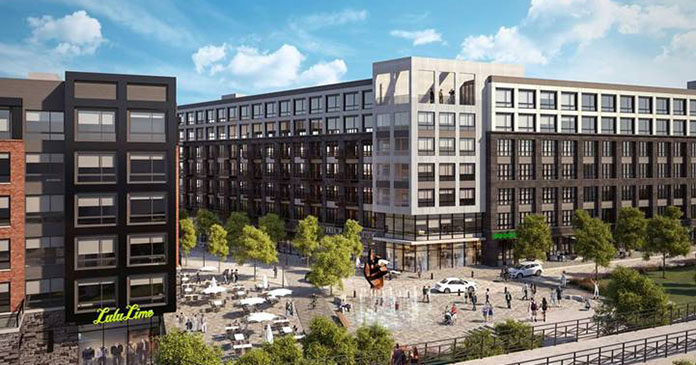MRP Realty, developers of commercial, residential, and mixed-use real estate across the Mid-Atlantic region, and FRP Development Corp, Inc., a full-service real estate company, today announce the formation of a joint venture to develop Phase I of Bryant Street, a mixed-use development in Northeast Washington, DC.
Bryant Street is a mixed-use, transit-oriented development on Rhode Island Avenue adjacent to the Rhode Island Metro Station (Red Line) and within a designated Opportunity Zone in Northeast Washington, DC.
“Bryant Street will ignite the transformation of this 13-acre site that residents—whether in Northeast or seeking to move there—have needed and wanted for many years,” said MRP Principal John Begert. “MRP has been active in bringing high quality homes and dynamic retail to similar underserved areas across the District and it will be exciting to bring this highly amenitized and multi-modal neighborhood to life. Edgewood and the surrounding communities near Bryant Street have a rich history and we hope we can build on the great offerings that already exist.”
This first phase will feature three mid-rise buildings with 490 multifamily units, a nine-screen Alamo Drafthouse Cinema, and an additional 40,390 square feet of ground floor retail. The first phase of Bryant Street will include significant public realm improvements including a plaza, a new urban grid, a dog park, a market building, ample outdoor seating for the public, and an improved Metropolitan Branch Trail including Metro pedestrian access adjacent to the site. At full build-out, the overall Bryant Street project will feature over 1,650 residential units and 250,000 square feet of retail on a 13-acre site in the heart of Washington, DC, adjacent to the Red Line.
“Having worked with MRP on Dock 79 and The Maren, two similarly high-impact developments in what was a fallow area along the Anacostia River near National’s ballpark, we are confident in our strategy for providing the ideal combination of retail, entertainment and restaurants alongside a robust suite of housing options,’ said David deVilliers Jr., FRP Development Corp President. “The location has virtually unparalleled access from walking, biking and scooters, to buses, subway and automobiles – at a true central nexus of the District.”
Bryant Street is woven within the existing neighborhood of Edgewood and situated between the established and rapidly growing neighborhoods of Eckington and Brookland. The development will physically tie the Edgewood neighborhood back together by creating a true street grid, extending existing roads into the property and improving pedestrian access to points north and west.
The central location along the Metro Red Line, Metropolitan Branch Trail and a major arterial roadway like Rhode Island Avenue allows residents multiple options for the daily commute, with Metro, vehicle/rideshare and bike access putting the District’s best amenities and employment centers within close reach. Bryant Street is easily accessible to Ivy City, Union Market, the newly opened Trader Joes and Bloomingdale’s hotspots such as Red Hen, Boundary Stone and Big Bear Café. In addition, one of DC’s hottest neighborhoods, Shaw, is less than 2 miles away.
Existing retail amenities will be expanded to support the dramatic recent and forecasted population growth, including with a future grocery store, entertainment uses, neighborhood-serving retail, and full-service restaurants all adjacent to and complemented by 1.5 acres of green space and public plaza that will host temporary and seasonal events and activities. Bryant Street will be built to LEED certified standards and will boast an above average Green Area Ratio, green roofs on all buildings, and a significant improvement to stormwater management over the current shopping center.
Holliday Fenoglio Fowler, L.P. (HFF) represented MRP Realty and procured the joint venture between FRP Development Corp and MRP Realty.
About MRP Realty
Founded in 2005, MRP Realty is a real estate operating company focused on opportunistic and value-add investment in the northeastern United States, with offices in Washington, D.C., Maryland, Virginia, Pennsylvania, and New York City. MRP provides to its institutional capital partners a full array of real estate services including: acquisition/disposition, development/construction management, property management, asset management and financial reporting services. Since the company’s inception, MRP has deployed $4.2 billion in total capitalization, an average of over $300 million per year. MRP’s combined development assets total more than 20 million square feet, with an additional 9+ million square feet under management.
About FRP Development Corp. (FRP)
Along with its sister company, Florida Rock Properties, Inc. (FRP) is a Maryland-based full-service development company specializing in commercial, mixed use, and industrial real estate. Incorporated in May of 1989, the company is a wholly-owned subsidiary of FRP Holdings, Inc., a Florida-based company, publicly traded on the NASDAQ Stock Exchange under the symbol “FRPH.”
About HFF
HFF and its affiliates operate out of 26 offices and are a leading provider of commercial real estate and capital markets services to the global commercial real estate industry. HFF, together with its affiliates, offers clients a fully integrated capital markets platform, including debt placement, investment advisory, equity placement, funds marketing, M&A and corporate advisory, loan sales and loan servicing. HFF, HFF Real Estate Limited, HFF Securities L.P. and HFF Securities Limited are owned by HFF, Inc.
About Qualified Opportunity Zones and Tax Credit Incentives under the Tax Cuts and Jobs Act
The District of Columbia has nominated 25 Opportunity Zones as vehicles to leverage and encourage targeted investment in the City. The selected zones were intended to focus on areas east of the Anacostia River, retail-heavy corridors and creative, industrial, and manufacturing zones, but most also share the distinction of having a strong development pipeline. Investments projects within the zone allow individuals and businesses to pool money for development while deferring taxes on gains from sales of assets within those tracts.













